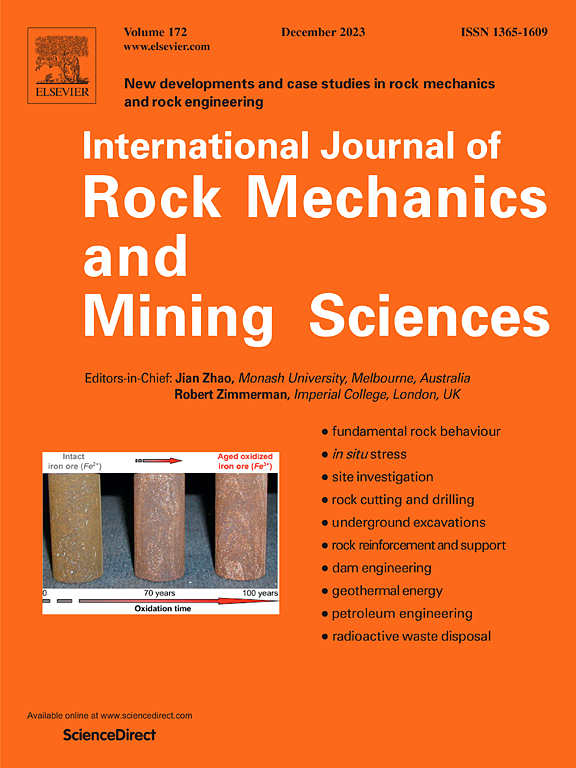通过热-液压-机械(THM)耦合模拟研究全尺寸工程屏障系统背后的物理机制
IF 7.5
1区 工程技术
Q1 ENGINEERING, GEOLOGICAL
International Journal of Rock Mechanics and Mining Sciences
Pub Date : 2025-07-16
DOI:10.1016/j.ijrmms.2025.106155
引用次数: 0
摘要
本文介绍了FEBEX实验的模拟结果,该实验使用2019年版本的热-水力-机械-化学耦合模拟器HYDROGEOCHEM 5.3 (HGC 5.3台湾电力公司版本)进行。这些模拟是DECOVALEX-2019项目的一部分。模拟考虑了变饱和流动、热输运和线性地质力学,包括膨润土膨胀的影响。本研究系统地研究了膨润土在近场全尺寸工程屏障系统中作为密封材料的水热力学过程。它探讨了一些重要的问题,如处置场地的工程屏障如何经历再饱和过程、热传递过程以及由此产生的应力行为。将模拟结果与实验结果进行比较,了解其物理机制。我们可以定性和定量地预测大部分实验结果,包括相对湿度的演变和径向分布、加热功率的演变、温度的演变和轴向和径向分布、总应力的演变、首次和最终拆除的饱和度和含水率的分布。通过这项研究,我们旨在更好地了解工程屏障材料性能演变背后的主要物理机制。这种认识将使我们能够评价近场工程屏障的功能,提高核废料处置安全评价和分析的数值技术能力。从这项研究中获得的见解可以应用于解决涉及这些基本过程的重要环境问题,特别是使用膨润土作为缓冲或回填材料的核废料处置库的安全性。本文章由计算机程序翻译,如有差异,请以英文原文为准。
Investigation of physical mechanisms behind full-scale engineered barrier systems through coupled thermal-hydraulic-mechanical (THM) simulations
This work presents simulation results of the FEBEX experiment, performed using the 2019 rendition of the coupled thermal-hydraulic-mechanical-chemical simulator, HYDROGEOCHEM 5.3 (HGC 5.3 Taiwan Power Company version). These simulations were carried out as part of the DECOVALEX-2019 project. The simulations consider the variably saturated flow, thermal transport, and linear geomechanics, including the effects of bentonite swelling. This study systematically investigates the hydro-thermal-mechanical processes in bentonite, which services as the sealing material in a near-field full-scale engineering barrier system. It explores important issues such as how the engineering barrier in the disposal site undergoes resaturation processes, thermal transport processes, and the resulting stress behavior. The simulation results are compared with experiments to understand the underlying physical mechanisms. We can qualitatively and quantitatively predict most of the experimental results, including the evolution and radial distribution of relative humidity, the evolution of heating power, the evolution as well as axial and radial distribution of temperature, the evolution of total stress, and the distribution of degree of saturation and moisture content for the first and final dismantling.
Through this study, we aim to better understand the dominant physical mechanisms behind the evolution of material properties of engineering barriers. This understanding will enable us to evaluate the functions of near-field engineering barriers and improve the numerical technical capabilities for the safety assessment and analysis of nuclear waste disposal. The insights gained from this research can be applied to address important environmental issues involving these fundamental processes, particularly the safety of nuclear waste disposal repositories that use bentonite as a buffer or backfill material.
求助全文
通过发布文献求助,成功后即可免费获取论文全文。
去求助
来源期刊
CiteScore
14.00
自引率
5.60%
发文量
196
审稿时长
18 weeks
期刊介绍:
The International Journal of Rock Mechanics and Mining Sciences focuses on original research, new developments, site measurements, and case studies within the fields of rock mechanics and rock engineering. Serving as an international platform, it showcases high-quality papers addressing rock mechanics and the application of its principles and techniques in mining and civil engineering projects situated on or within rock masses. These projects encompass a wide range, including slopes, open-pit mines, quarries, shafts, tunnels, caverns, underground mines, metro systems, dams, hydro-electric stations, geothermal energy, petroleum engineering, and radioactive waste disposal. The journal welcomes submissions on various topics, with particular interest in theoretical advancements, analytical and numerical methods, rock testing, site investigation, and case studies.

 求助内容:
求助内容: 应助结果提醒方式:
应助结果提醒方式:


